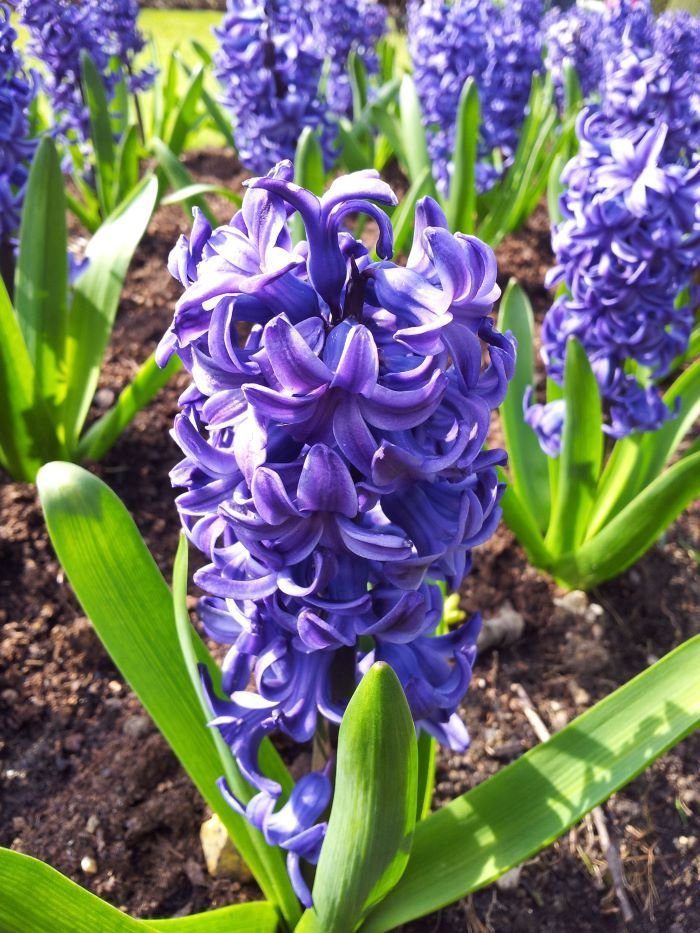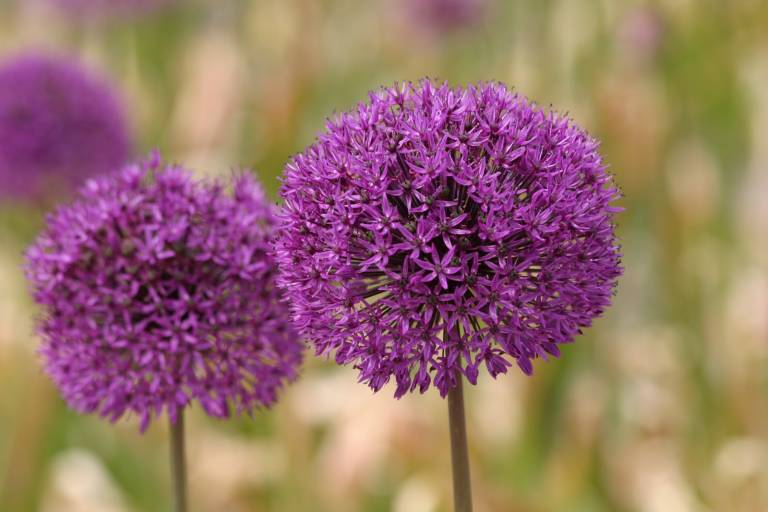Time to Shop for Spring Bulbs: 12 Beautiful Types
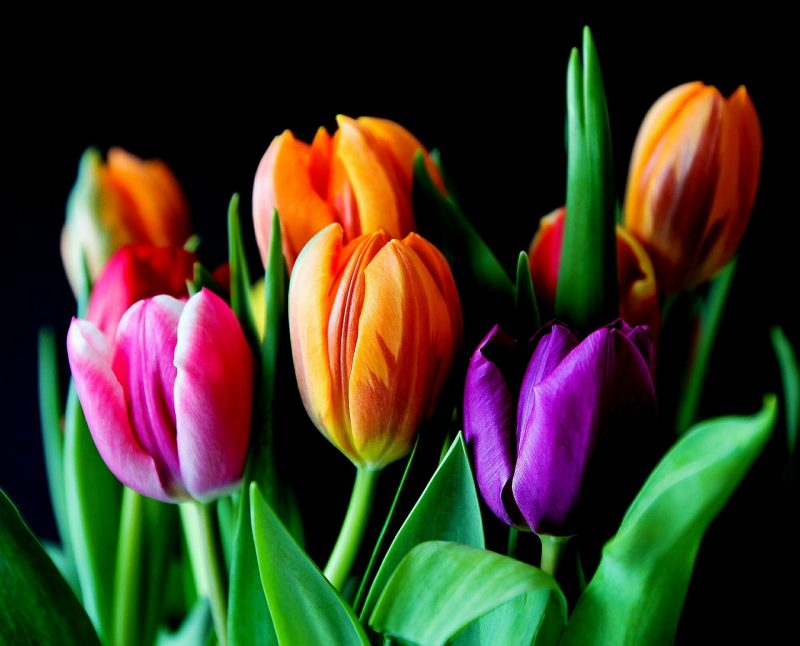
By Linda Lee
There is still life in the garden, the dahlias, the chrysanthemums, black-eyed Susans, snap dragons, the zinnias, the giant asters. But the clock is running out. Soon the first hard frost will come, and that means those clean-up chores: raking, clipping stalks to the ground, piling waste in the compost heap.
But it will also be time to go online and put in your orders for next spring’s bulbs. (Flower Power has no connection to any of the nurseries we recommend here.) The companies will ship bulbs when it is time to plant in your zone.
You plant in the fall because these flowers will burst into bloom and gladden the spirit when snow is still on the ground. They bring hope that bleak midwinter will not last forever. Some of them, like the miniature iris, come up as early as March as far north as Zone 5.
Here’s another thing: Most spring bulbs, especially the early ones, are unappealing to deer, squirrels, chipmunks, rabbits, you name it. Some of them are even poisonous to the furry creatures. As a result, they don’t get eaten, and if you plant them with the bulbs that do get eaten (tulips, crocus) there is a chance the those will be avoided too.
I personally adore my miniature daffodils because they are such perfect replicas of their full-sized relatives, which won’t arrive for another month or so. The only problem is that I have to get down on the ground to admire them.
Plant the early, tiny bulbs in a rock garden, where they have a better chance of being admired at eye level. Or put them on a south-facing hillside where they can naturalize, a place that won’t have to be mowed. Or in a narrow bed along a sidewalk, where you will enjoy seeing the progression of little flowers as the months pass. A retaining wall is perfect. Think of what plants can grow there later, things that shoot up quickly and die down in the fall. Or seed the beds with annuals like zinnias, marigolds and wildflowers.
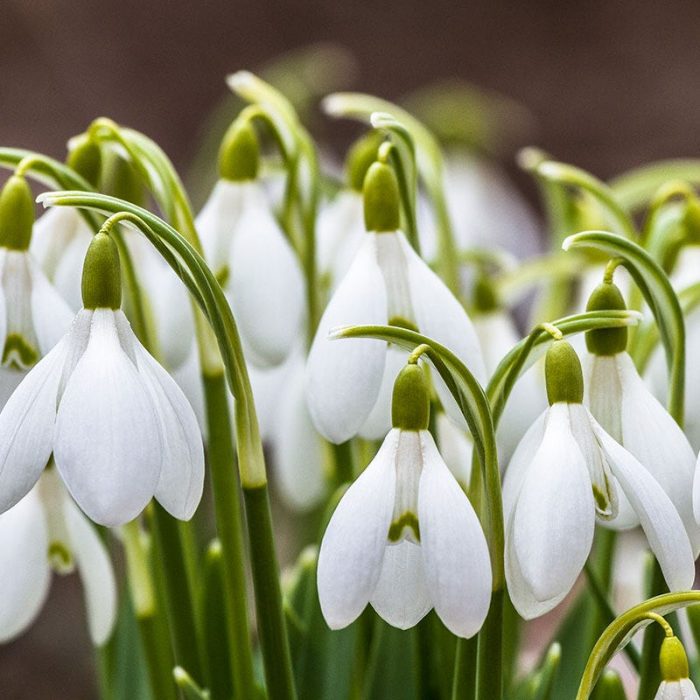
Snowdrop (Galanthus woronowii)
Because these wildflowers are white, and tiny, children may find looking for them in the snow a joke, something like a snipe hunt. But they are real, and they are there, if the snow isn’t deep, and you know the bulbs were planted. The one shown here, from American Meadows, grows six to eight inches tall.
Almost all species of Snowdrops (not to be confused with Snowflakes or Leucojum vernum) bloom before the spring Equinox, which in most northern states in the US is a time when snow can still be expected. The flower is made up of three larger white tepals sheltering three smaller white tepals. In England and Scotland (Romans introduced the Snowdrop to the Scepter’d Isle, although of course the Romans did not conquer the Scots) some woodlands are known for their early spring snowdrop gardens.
American Meadows charges under $14 for a bag of 15, but it will take many bags to carpet a woodland. Luckily, Snowdrops, like all of the little bulbs, spread and multiply and are impervious to mice, voles, squirrels and other pests. Perhaps your grandchildren will appreciate your Snowdrop woodland.
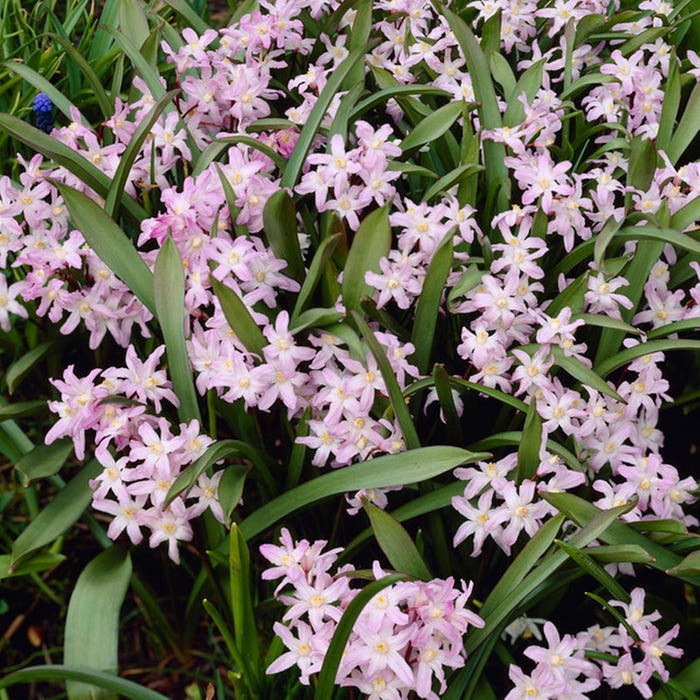
Glory of the Snow
True to its name, Glory of the Snow blooms early. Chionodoxa forbesii originated in Turkey, as did so many of these early bulbs. Turkey or the Ural Mountains, or somewhere in this region, because the plant was discovered by humans long before there were national boundaries. Pretty little plants were bartered not just for their looks but for possible use in medicine, flavoring, food and dyes.
Early humans were excellent botanists, recognizing small but critical differences in plants. It was essential for their survival. New plants traveled fast and far along trading routes, among families and neighbors. And, as seen above, carried by the Romans.
The typical Glory of the Snow is blue. The one above, called Giant Pink Glory of the Snow, is $8.44 for a bag of 22 bulbs from American Meadows. And if you are wondering what “giant” means among these early bulbs, it means six-to-eight inches tall.

Crocus
Any gardener looking at that patch of crocus above would get itchy fingers, because half of those bulbs should be dug up and transplanted. They are too crowded! But of course this is a grower’s idea of a picture that will make you want to buy bulbs. Crocus are in a foot race with Glory of the Snow for popping out of the ground next. Crocus flowers appear like an umbrella suddenly unfolding. There is no warning, no leaves, no stem. Suddenly a burst of color flat on the ground. And then another one.
If you have bought big, healthy bulbs from a Dutch dealer like K. van Bourgondien you will probably be rewarded with big, juicy pops of color. Be sure to plant crocus bulbs in well-drained soil about three inches deep, so the bulbs don’t rot before springtime.
This is a wonderful task to plan with the children, a little like a reverse Easter egg hunt. Let them decide where they would like to surprise you with crocus flowers in the spring. The crocus won’t mind being under deciduous trees and bushes, because they will be out before the leaves. The children will enjoy adding a dash of hot pepper sauce to the hole on top of each bulb, to discourage the mice and chipmunks.
Crocuses are those few spring bulbs that fall prey to furry creatures. Luckily they are cheap enough to plant for volume over predation.
Miniature Daffodils
Miniature daffodils can grow “up to” six inches tall. That’s it. But they are perfect little daffodils, and they come early. As you can see from the ones above in my previous garden in Pennsylvania, they can even be dwarfed by muscari, and make a lovely combination. The muscari were already established when we moved in, and took over without any encouragement. The addition of the early daffodils broke up the blue wave.
The most popular miniature daffodil (the American Daffodil Society does not recognize the classification) is Tete a Tete (a pure yellow), but there are some super cute ones, including Baby Boomer (tiny golden cup and miniature petals), and Minnow (yellow cup and white petals).
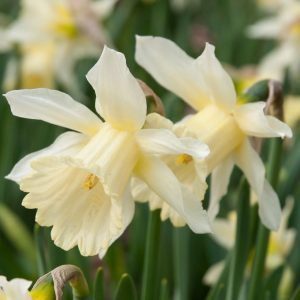
The ravishing creamy white W.P. Milner, above, can be purchased from the wholesaler Colorblends. It is an heirloom miniature, dating to before 1869, and Colorblends sells 100 of them for $34. At that price you can plant an entire bed of creamy white, ruffled miniature early daffodils. W. P. Milner stretches the definition of miniature, being almost nine inches tall.
The planting instructions, however, give you a sense of the size of the bulbs: the suggestion is to plant eight or nine bulbs a square foot, so the little daffodils won’t look lonely. They can also be forced indoors, for a pretty show on the windowsill.
Dwarf Iris
Dwarf iris, also known as iris reticulata or, netted iris, is an early star. There are two problems. They are really early, and they are really small, five inches max. If you are looking for them in the snow, you will probably see the tips of the sharp, spear-shaped leaves first.
Luckily, dwarf iris have a lot of devotees, many of them Japaneses, who have bred an array of beauties, from almost black – the usual obsession – to yellow, blue and purple, all with that orange stripe down the middle of the “fall,” the correct term for that lower petal, the same nomenclature as the regular iris, with the tall parts called the “standards.”
The brilliant blue variety called Harmony is the most popular. Make sure visitors don’t confuse these miniature iris with crocus. Crocus lie flat on the ground. These iris have stems and don’t look anything like crocus. Also, they aren’t Siberian Iris, which are much taller, and bloom later. (See our entry on growing iris for a more complete discussion of the family, including bearded iris and Siberian iris.)
Brecks, a reliable Dutch bulb producer, sells a package of five dwarf iris rhizomes for $30. These are fancy, bi-color “dwarf iris,” in assorted colors, and are promised to grow 10 inches taller or more. They look suspiciously tall to me, and appear more like bearded iris.
You might do better with Holland Bulb Farm‘s plain old Harmony blue dwarf iris, the standard one. They sell a bag of 25 bulbs for $6.
Note that I, and everyone else, calls them bulbs. Yes, they are rhizomes. But we include them with spring bulbs. Irises arrive as fans of leaves attached to rhizomes. You plant the rhizome, the fleshy part above the roots, at ground level. The fans will grow out of the sun, and do not want to be wet; even the roots should be well drained. Root rot is your enemy.
Irises do very well without any watering at all after they bloom. But don’t plant iris too close together. Even the dwarfs will multiply, and eventually push themselves out of the ground. Lucky you: you will now have more dwarf irises to transplant or give to friends.
Squill
Squill or scilla are perfect for naturalizing under trees or on the lawn. They get all the sun they need before the deciduous trees are in leaf, and they are finished blooming before the lawn needs mowing. Meanwhile, early in spring, you are welcomed with a carpet of blue. Eventually. As with everything in gardening it takes time for the Scilla Siberica to spread (unless you want to plant 1,000 bulbs; if so, go ahead!).
You don’t plant them deep, and you don’t plant them very carefully. It’s more like dumping a dozen bulbs into a square one-foot hole, two inches deep, hoping most of them land pointy end up. Your biggest decision is what kind of Scilla. Sure you can go with Spring Beauty, shown above from Easy to Grow Bulbs, which sells them 10 for $4.95. The photo is deceptive. They are tiny flowers, just a few inches above ground. Easy to Grow Bulbs also sells exotics, like tiny Rosy Squill, Squill Madeira, which blooms in the fall and is meant for the window sill, Amethyst Meadow Squill, a kind of blown-up muscari; and the ice-blue Persian Blue squill.
There is also a variety call Alba, which is pure white. Because Squill bloom the same time as miniature daffodils, they make a wonderful couple.
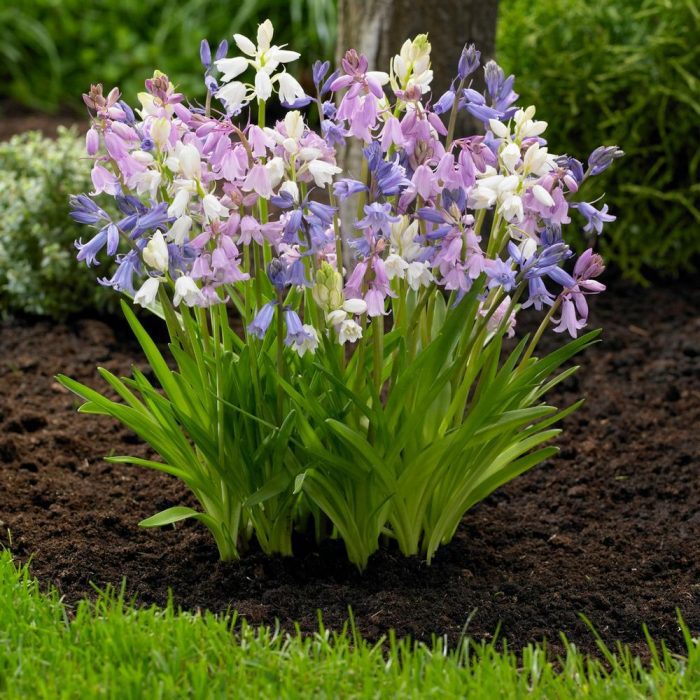
And then there is a second kind of squill: the lesser known squill campanulata. It blooms in late spring, and sometimes called Spanish Bluebells. As you can see from the above it has been bred to produce soft pastel colors. The reliable Longfield Gardens sells a bag of 25 bulbs for $10; these cheerful squill would be lovely in a rock garden or border around Easter or May Day.
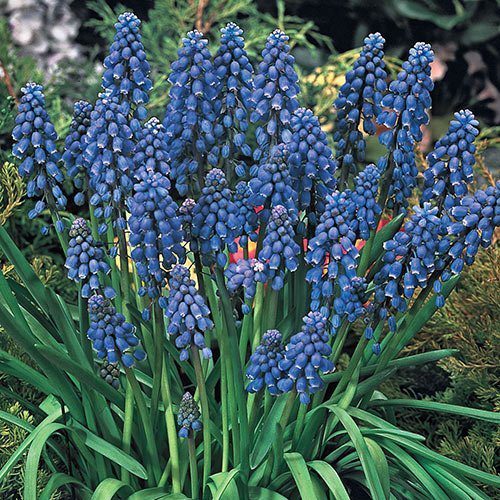
Muscari
An early blooming variety with bright blue, bell-shaped flowers in grape-like clusters, this muscari, also called grape hyacinth, grows about three to four inches tall. Because of the time of year it blooms, from mid- to late-spring, it works well as a planting in a bed of daffodils. Dutch Bulbs calls the muscari shown above Landscapers’ Choice, because it costs $15 for a bag of 100 bulbs. That means a big area can be liberally planted with these little darlings.
Dutch Bulbs will also sell you muscari in other shades: pink, blue-and-white, pure white, purple, a pale blue, even a bizarre combination of yellow and purple.
But the blue of the classic muscari and the other early bulbs – blue squill, iris, the standard blue glory of the snow – seem preferable. They make for a simple color formula against yellow daffs.
Spring Snowflake (Leucojum vernum)
There are Spring Snowdrops, and there are also Spring Snowflakes. (If you get them confused, it’s OK. I call my muscari “squill.” I am wrong, but I just going to keep doing it.) Snowflakes come up in late spring, but some feel are worth the wait. You will have to decide if they are worth the price. The regular ones grow only six to twelve inches tall and the bells are tiny. They are fragrant, but at a certain point you might find yourself asking “Why not just plant Lily of the Valley pips?”
Of course Spring Snowdrops want to be in the sun, and Lily of the Valley want a nice shady spot, so if you have a sunny spot that needs some late spring, sweet smelling, low growing, white bell-shaped flowers, what are you going to do? And Spring Snowflakes have much to recommend them. As long as they don’t get their feet wet, they are easy to grow. The ones above, from Bluestone Perennials, are a little taller – nine to twelve inches tall, $6.95 for a bag of five bulbs.
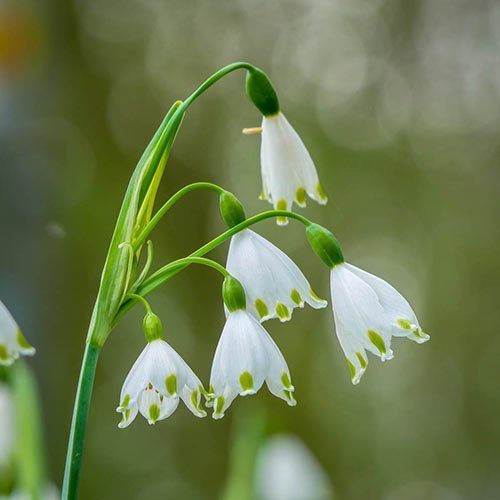
The Giant Spring Snowflakes shown here, from the Michigan Bulb Company, can reach 18 to 30 inches tall. I’m not seeing any reviews testifying to that height, but for a price of under $15 for eight bulbs, it might be worth a try. They need to be planted six inches deep. Deer don’t like them. A frothy patch of eight white Spring Snowflakes in a bed of red Emperor tulips could be a winner.
And Now for the Big guys of Spring
 Daffodils
Daffodils
King Alfred. Do we need to say more? It sometimes seems that every yard in America must have King Alfred daffodils in it. Home Depot sells a bag of bulbs called “Dutch Master,” that brags it is “an improvement on the famous King Alfred…” It is possible to look online and find bags of 50 mixed bulbs (all white, yellow and white, orange and yellow, short cup, trumpet cup, all yellow) from a reputable grower for $40. Those 50 bulbs will take some time to plant. Take it from me. Do not order more than that, unless you invite 10 friends to help you.
You want each bulb to be planted in an individual hole, six inches deep. These daffs are going to multiply, but you will never have to think about them again. For the next hundred years, those daffodil bulbs will be brightening the spring. And for the hundred years after that. If you doubt me, go to farmland in Wales. The deer won’t touch them. They can be planted in the woods, on the edge of the lawn, along the sidewalk or driveway. In the garden, of course. But you are going to have to tolerate some dying daffodil foliage, which will feed the bulb for next year. Some people neatly bundle the dying foliage, but somehow, to me, that looks worse. Let it be.
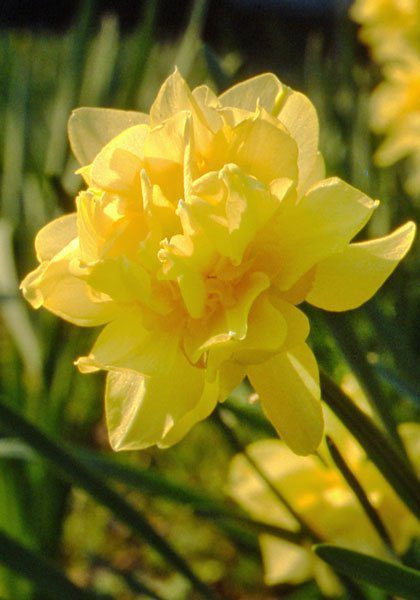
And then there are the species and rare daffodils. If that is your thing, you might like Old House Gardens, with its six pages of rare and unusual daffodils, including Butter and Eggs, above, which Old House Gardens considers one of the rarest, but also one of the oldest daffodils, dating back to 1777. They charge $16 for 5 bulbs. Why not five of those yellow beauties near the front door? That would cheer anyone up. Next to some squill, of course. Also see Flower Power’s entry in the Garden section on growing daffodils.
Hyacinth
Can there be too much of a good thing? That depends on how much you like the smell of hyacinths. They are heavily perfumed and most guides suggest you plant them near the front door, and in groups. Most also suggest you treat them as annuals: plant them in the fall, six inches deep, enjoy the spectacular display mid-spring, when they bloom just about the same time as tulips. Cut the flowers, take them inside, to enjoy the perfume.
After a while, these growers say, dig up the bulbs and throw them away. Because, they say, the next year, the hyacinth flowers will never be as beautiful as they were the first year. Note, growers might just want to sell you new hyacinth bulbs next fall.
My hyacinths come up every year, in the same place, and they look just fine. So much for that.
But, if you want new or different hyacinths, you might order a nice mix of 12 in shades of blue from White Flower Farm for $22.75. I would not suggest planting all 12 in the same place. That much hyacinth fragrance might make the FedEx delivery person steer clear of your front door. Instead put a few down near the street. More out in the far reaches of the yard, to give you a reward for strolling out there. Some near the trash cans. Ok, a few near the front door. They look great mixed in with the daffodils.
Hyacinths are about a foot tall, so regular daffodils are going to tower over them. But their dense flower heads make them a solid presence.
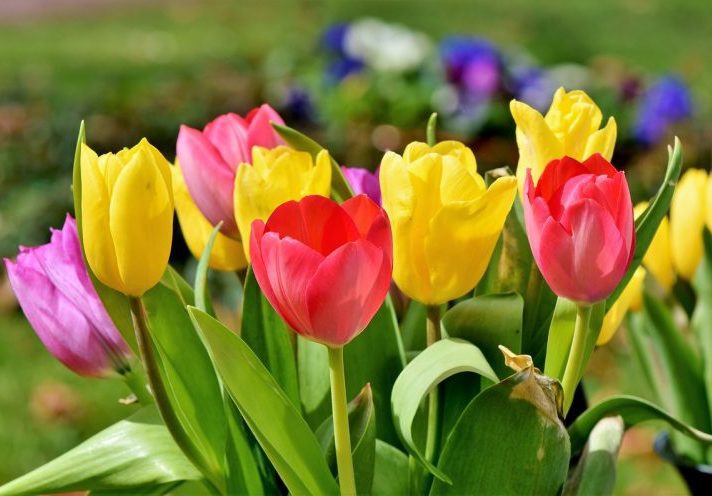
Tulips
It is easy to predict that tulips are everyone’s favorite spring flower. For one thing, they come in so many colors. For another, there are so many different kinds, they will bloom over several months. The earliest tulip is in some ways the best: it is huge and comes back year after year: the Fosteriana or Emperor Tulip. Tulip World sells a sherbet colored Brilliant Orange Emperor with gray-green leaves that grows 15 to 18 inches high, 25 bulbs for around $11. After that, most of the early tulips are little guys, around a foot tall, but Longfield Gardens sells a double early called Margarita, 18 inches tall, that can range from deep pink to deep magenta, 10 bulbs for around $9. Early in this case means mid-April. Darwin hybrids, below, are the most popular of all tulip types. The petals are tight, wider at the base, narrower at the top.
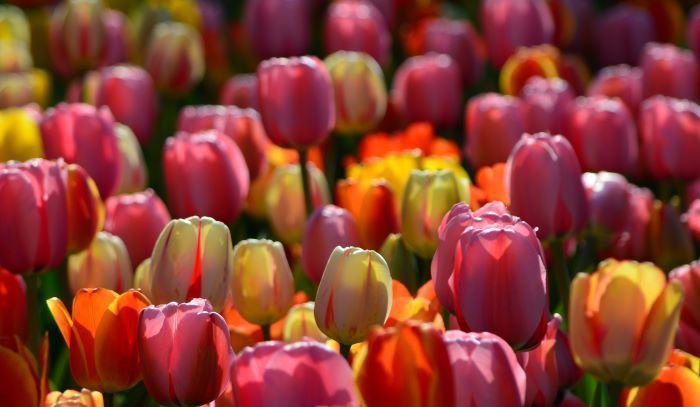
The Darwins are the ones you see planted along Park Avenue in New York. They will come back for three or four years in your yard and garden. They are tall, 14 to 16 inches, sturdy, impervious to wind and rain.
Most of the Darwin hybrids are in the yellow and red color range, or a combination of the two, like Apeldoorn.
Still want more kinds of tulips? We’re not done. Now we’ve got the Triumph tulips, which bloom a little later, more toward the end of April. Here is where all those exotic colors come in: white, dark purple, peach, every conceivable shade and sometimes streaked with two colors. The shape of the Triumph tulip is not as narrow and triangular. Instead it is more cup-shaped, although some Triumphs look a lot like Darwins, and in fact are a cross between Darwins and early tulips.
Rembrandt or painted tulips no longer get their spectacular markings from a virus or fungus, but from careful breeding. Still, the delicate and pale beauties seen below from Spring Hill Nursery are pretty hard to resist after all those blasts of strong color by the Triumphs. These Rembrandts also bloom mid-spring, 18 to 24 inches tall, 10 bulbs for around $10.
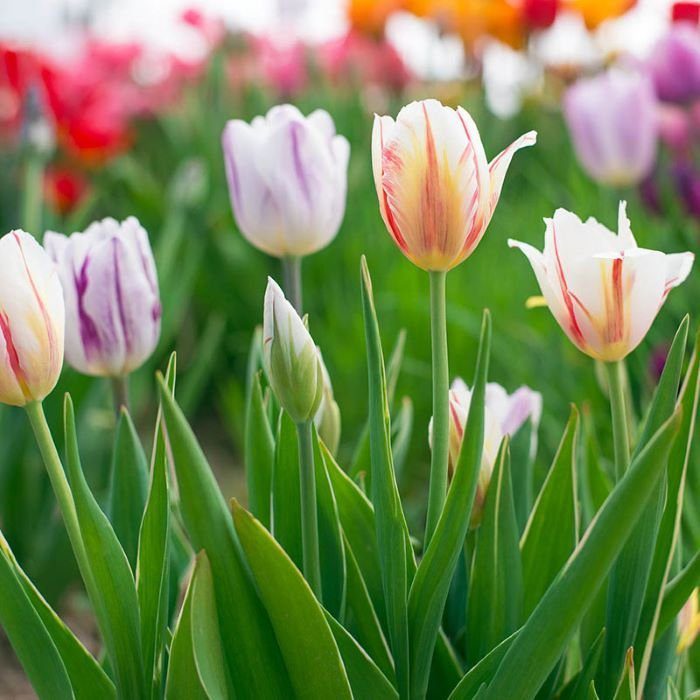
And we are still not done with tulips. Because as any gardener knows there are still the parrot tulips and the lily-flowering tulips and the peony-flowering tulips. These all come at the end of the tulip blooming season. Parrot tulips like the gaudy Estella Rijnveld are heirloom tulips, and fanciers will sit around talking about seeing their “first Estella Rijnveld” the way astronomers talk about rare comets. You can debate whether it is red with white streaks, or white with red streaks, but the plant world judgement is that it is a white ruffled tulip with red streaks.
There is also a “Black Parrot.” Of course. And there is one more. (Well, we’re skipping the Green tulip.) And that is the very late, and very tall, elegant French Single Late Tulip. On the grounds that the French do everything better (after all, they restored the reputation of the carnation) they would of course have only the best tulips. The French Tulip blooms in May, and reaches 20 to 27 inches tall on straight stems with slim, egg-shaped flowers in a range of colors. White Flower Farm sells 25 of them for $24.
As with all tulips, it is good to get them into the ground and watered in time for them to start growing roots in the fall. They will go to sleep for a period of winter dormancy but when the temperature and daylight hours meet their requirements, they will unfurl their startling beauty. Worth the price. See also our section on planting and growing tulips.
Allium
Allium is one of Jill Brooke’s spring favorites, those stately, tall globes marching down the formal walk of her gardens. It is amazing how sturdy those stalks are, holding the flower head aloft, even if the stalk is four feet tall. The increasingly exotic cultivars can make for a spectacular display.
Shubertii looks like a fireworks display, with little pink stars shooting out from the center. Bulgaricum (Summer Bells), on the other hand, doesn’t even look like an allium, with it’s umbrella of pendulous pink and white downward facing bells.
Dutch Grown, in Pennsylvania, sells 10 for $5.30 and says they make great cut flowers (you want to harvest your allium, so they will come back next year instead of going to seed), and have a spectacular scent.
What’s to lose? There are also allium that look like Hot Poker flowers, like spider chrysanthemums, and of course the giant puff balls, which these days come in pink, blue, purple, pink, white and almost red. Longfield Gardens has a useful chart of the bloom times of 12 different kinds of allium, from late spring to early summer. They make a nice bridge flower between tulips and roses. See also our entry on planting and growing allium.
Linda Lee is a former editor at The New York Times. She was the deputy editor of the House & Home section, where she edited the garden column, and she wrote frequently for Sunday Styles.

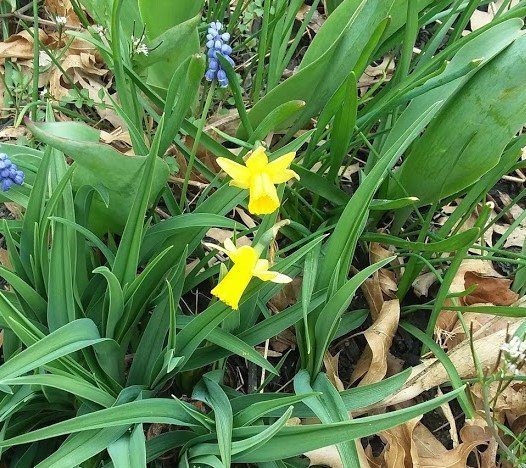
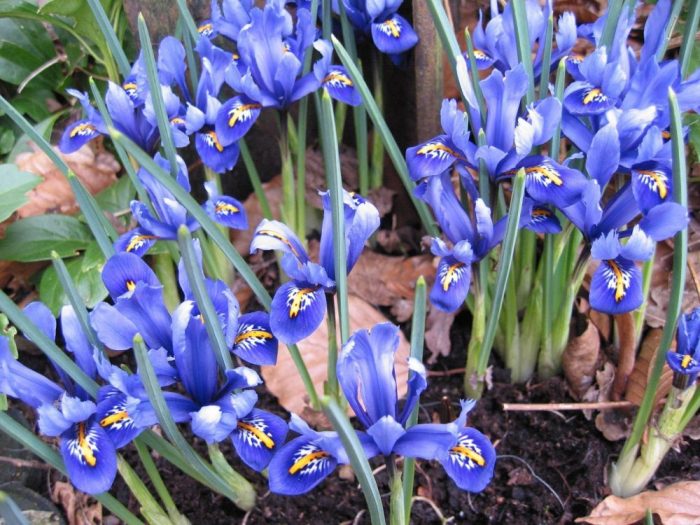


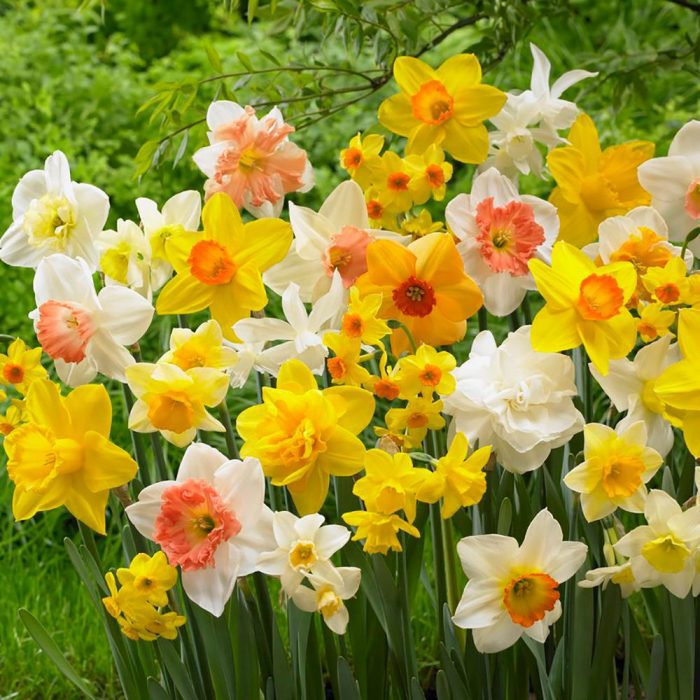 Daffodils
Daffodils